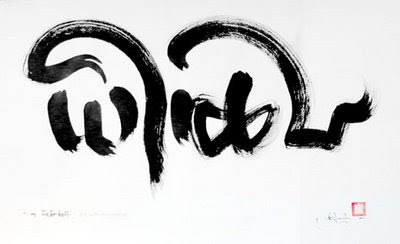Calligraphy is a kind of visual art and in recent times has been receiving its due status as an art form. Often called the art of fancy lettering it demands that the artist be highly disciplined and its painterly qualities of fluidity and spontaneity are what rescue it from being a mere technical skill! The test of a true calligraphed page is its capacity to present text with continuity and rhythm. The tools of calligraphy are deceptively simple - a quill pen and a pot of water based ink. But practising calligraphy to perfection takes a lifetime.
As it is with each culture having their own distinct style and language, so it is with calligraphy. Lets look at some of them...
Persian calligraphy - The horizontal, vertical and diagonal letters done in a linear sharpness have earned this form of calligraphy the status of "the script of nails". It is consideed the bride of the calligraphic forms and is widely used to create animal shapes in lettering. Its strong structure and visual beauty have been fine tuned over seven centuries, across the plateau and as far as India.
Arabic Calligraphy - This evolved alongside the Arabic language and is associated with geometric art linked with spiritual art. Many proverbs and passages from the Quran are sources for the calligrapher. Even today some of the best works can be sourced from Turkey where monuments and buildings are considered as open exhibitions of this art form!
Chinese calligraphy - This art form is more than a display of monotonous brush strokes. This was once a scholarly requisite, and learning commanded power. This calligraphy when seen today creates a peaceful and reflective mental aura. The repetitive strokes, both heavy and linear, denote strength and sagaciousness. Their interplay simulate the foces of nature and the energy of the human body - both yin and yang!
Buddhist Calligraphy - A form of devotional practice, this is prevalent even today all along the Himayalyan region, especially Tibet, Nepal, Bhutan and North india. The lamas are adept in creating scrolls adorned with calligraphic writing, on surfaces ranging from wood to walls, stone tablets, silk and paper. Letters to dignitaries of the monastic order are addressed in calligraphic missives till date.
Baroque Calligraphy - When Europe entered the Dark Ages and learning was confined to monasteries, calligraphy became the method for copying holy scriptures, paticularly the Bible. The art has rhythm and geometry in each character. Precise stroke orders were ordained and the pen, parchment, brushes and vellum were the tools.
Modern Calligraphy - This is a free form of lettering using the script of many languages. Its strength lies in being innovative and attention-grabbing. No material is taboo for this art form and everything from computers to handmade paper have been used by its creators.


















3 comments:
Wonderful! I really wish I was better at this! Great post & blog.
Funny thing the cramping of fingers! My handwriting's gone sloooow and crazy for lack of use...
:(
Post a Comment